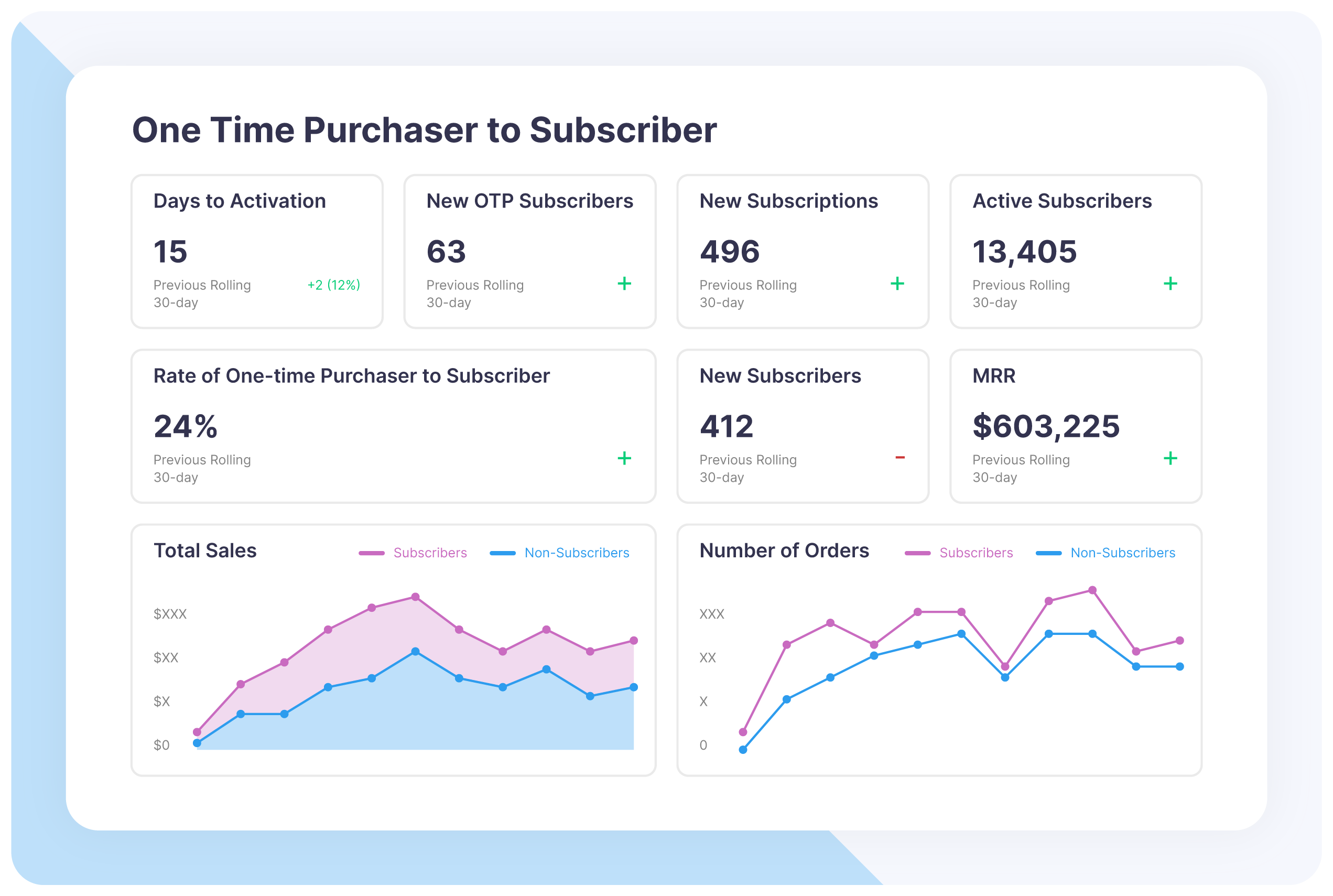Subscription Activations
One-Time Purchase to Subscription Metrics. Analysis that measures behavior between one time purchasers who become subscribers.
A collection of 5 metrics that look at the behavior of one-time purchasers who become subscribers in a subscription business. These metrics are available only through a direct integration with our Recharge & Bold integrations & Smartrr .
Value
Many subscription businesses have customers who may purchase their products as one-off transactional purchases but they really want them to become subscribers on auto-billing. They nudge them to go on a subscription plan via a variety of experiments, and want to know - does this work? Are "one-time purchasers" becoming subscribers? This suite of metrics will help you understand this behavior use case.
- How many people make a one-time purchase and then does it turn into a subscription?
- What is the number of days between the first one-time purchase and the first subscription? ==
Days to Activation - When to send campaigns to one-time purchasers to promote subscription? ==
Days to Activation& thenRate of One-time Subscriber*New OTP Subscribersto see if the experiment increased the % - Are my subscribers subscribing and never purchasing things before or are the majority of my customers one-time purchasers who then become subscribers? ==
Rate of One-time Subscriber - What is my total number of active subscriptions on any given day? ==
Active Subscriptions - What is the number of new subscribers? How many people are joining our subscription program? ==
New Subscribers - What is the number of one-time purchase customers becoming subscribers? ==
New OTP Subscribers

Metric | Definition | Use Case |
|---|---|---|
Rate of One-time to Subscriber | Percentage of daily subscribers who had first made a one-time purchase earlier. Formula: The date is when they became a subscriber. | This metric looks at all the subscribers today and see how many had placed a one-time purchase before. It tells you the percentage of your subscribers that had a one-time purchase in their purchase history. It allows you to answer the question - Are my subscribers subscribing and never purchasing things before or are majority of my customers one-time purchasers who then become subscribers? XX% of new subscribers were OTP before. When it is high, it means that one time purchasers are a great driver for subscription. If you are wondering if you shouldn't have one time purchases, then this is the metric to tell you if people try the product before they subscribe. If it is zero, then maybe rethink one-time purchase behavior, but if it is higher, you will see the opportunity Sending campaigns to one time purchasers to tell them to subscribe. We see in Days to Activation metric the average amount of time when people activate to be a subscriber, so this metric tells you the success rate of that. If the Days to Activation metric is growing, but the Rate of One-Time to Subscriber metric is going up too, then it is success because you are converting a larger % of those OTP customers. You want this metric to increase because ideally you want all your One Time Purchasers to Subscriber. Since subscribers commit to buying from you ever month/week versus one time purchasers only do one off transactions & could easily never come back. |
Activation Rate | Percentage of customers from the past 30 days who became subscribers today. | |
Days to Activation | The number of days between the first one-time purchase and the first subscription. Formula: | This is looking at the average number of days between when people subscribed and when they made their first non subscription order. Depending on how many subscriptions you have, it is best to look at this monthly, but of course can look at any timeframe. Start with monthly. "For people that subscribed in May, it was an average of XX das since their first one time purchase." "Satisfied customers will come back and subscribe within XX days." This is the time window to really push communications to encourage people to join your subscription program. If you see zero, its because you didn't have New OTP Subscribers in that time window. Read on to the next metric, |
New OTP Subscribers | The number of new unique subscribers among customers who first had made a one-time purchase. This is counting customers instead of subscriptions. The month they appear is the month that they subscribed. This metric is counting subscribers who first made a one time purchase. They became subscribers in the time period shown here. When we segment by for example -- the product, this is the product that they subscribed to in their first subscription order. | You can use this metric to track if the experiments you are doing to activate one-time purchasers into subscribers. Are they improving? On an average, these were people that were one-time purchases and subscribed. They had a one-time purchase and then they subscribed. |
Subscriber Rate | Subscriber Rate is looking at number of customers that are and become subscribers over time in that cohort. It is the amount of subscribers compared to all customers. We are counting the number of subscribers as those customers who has an active subscription by the end of the period, this mean that the subscription was created before the end of the period, and by the end of the period is still active | You are trying to understand the scope at which the subscription size of your business is compared to the rest of your business. |
Updated 7 months ago